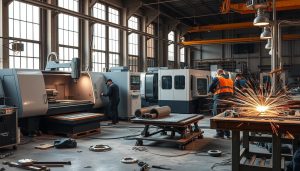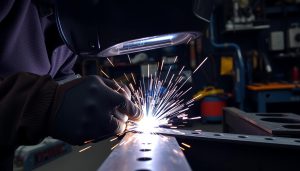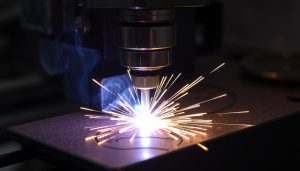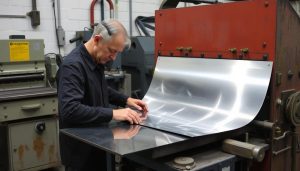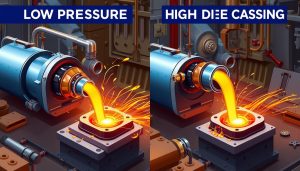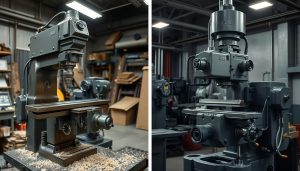In the world of metal fabrication, low pressure die casting stands out as a versatile and efficient process that is transforming the way manufacturers approach component production. This comprehensive guide delves into the intricacies of low pressure die casting, exploring its advantages, applications, and how it compares to other casting methods.
Low pressure die casting is a metal forming technique that has gained significant traction in industries ranging from automotive to aerospace. By leveraging the power of controlled, low-pressure injection, this process enables the creation of complex, high-quality parts with exceptional precision and consistency. Whether you’re an engineer, a manufacturer, or simply curious about innovative metal shaping technologies, this article has everything you need to know about low pressure die casting.
What is Low Pressure Die Casting?
Low pressure die casting is a highly efficient metal forming technique that uses low-pressure injection to fill a mold with molten metal. This innovative process offers several advantages over traditional casting methods, making it a preferred choice for a wide range of industries, from automotive to aerospace.
Overview of the Low Pressure Die Casting Process
The low pressure die casting process involves a series of carefully orchestrated steps. First, the molten metal is heated and held in a furnace or crucible. Then, a low-pressure system is used to push the molten metal into a die cavity, where it solidifies into the desired shape. This controlled injection and solidification result in high-quality, near-net-shape castings with exceptional dimensional accuracy and surface finish.
How Low Pressure Die Casting Works: Injection and Solidification
The key to the low pressure die casting process is the precise control over the metal injection and solidification stages. During the injection phase, the molten metal is pushed into the die cavity using low-pressure air or gas, typically between 15 to 100 psi. This gentle, controlled flow helps to minimize turbulence and reduces the risk of air entrapment, leading to a higher-quality final product.
As the molten metal fills the die cavity, it begins to cool and solidify. The carefully designed die and cooling system ensure that the metal solidifies in a controlled manner, minimizing defects such as porosity and improving the overall mechanical properties of the casting.
Benefits of Low Pressure Die Casting
The advantages of low pressure die casting are numerous, making it an attractive choice for a wide range of applications. This versatile manufacturing process offers several key benefits that set it apart from other casting methods.
Reduced Porosity and Defects
One of the primary advantages of low pressure die casting is its ability to produce parts with significantly reduced porosity and fewer defects. The controlled, low-pressure injection process ensures a more consistent and uniform material flow, resulting in castings with higher density and structural integrity. This translates to improved product quality and reliability, reducing the need for costly post-processing and rework.
Improved Material Flow and Strength
Low pressure die casting also excels in promoting excellent material flow and enhancing the overall strength of the finished parts. The gradual, low-pressure injection technique allows the molten metal to fill the mold cavities more efficiently, minimizing turbulence and air entrapment. This, in turn, leads to parts with superior mechanical properties, making them well-suited for applications requiring high strength and durability.
Ideal for Aluminum and Other Metals
The advantages of low pressure die casting make it particularly well-suited for working with aluminum and other non-ferrous metals. These materials, known for their lightweight and corrosion-resistant properties, are widely used in industries such as automotive, aerospace, and general manufacturing. The low-pressure casting process ensures that these metals flow seamlessly into the mold, resulting in high-quality, high-strength components.
“Low pressure die casting is a game-changer for manufacturers looking to produce parts with superior quality and performance. The reduced porosity, improved material flow, and suitability for aluminum and other metals make it a standout choice in the industry.”

Applications of Low Pressure Die Casting
The versatility of low pressure die casting makes it a popular choice across a wide range of industries. From the automotive sector to aerospace and general manufacturing, this advanced casting process is employed to create a diverse array of high-quality metal components.
Automotive Industry: Wheels, Cylinder Heads, and More
In the automotive industry, low pressure die casting is extensively used to manufacture essential parts such as wheels, cylinder heads, and other critical components. The process allows for the production of intricate, lightweight, and durable parts that meet the stringent quality and performance requirements of the automotive market.
Aerospace and Defense Components
The aerospace and defense industries also rely heavily on low pressure die casting to produce high-precision components for aircraft, spacecraft, and military equipment. The process ensures the creation of lightweight, yet strong parts that can withstand the demanding conditions encountered in these applications.
General Manufacturing
Beyond the automotive and aerospace sectors, low pressure die casting finds applications in a wide range of general manufacturing industries. From household appliances and electronics to industrial machinery and tools, this casting method is utilized to create a diverse array of metal components that require consistent quality, durability, and performance.
| Industry | Low Pressure Die Casting Applications |
|---|---|
| Automotive | Wheels, cylinder heads, transmission parts, brake calipers, engine blocks |
| Aerospace | Aircraft components, spacecraft parts, defense equipment |
| General Manufacturing | Household appliances, electronics, industrial machinery, tools |
The wide-ranging applications of low pressure die casting demonstrate its versatility and value in meeting the evolving needs of various industries. As a highly efficient and cost-effective casting method, it continues to play a crucial role in the production of high-quality automotive parts, aerospace components, and a diverse range of low pressure die casting applications.

Low Pressure Die Casting vs High Pressure Die Casting
When it comes to the world of die casting, there are two primary methods: low pressure die casting and high pressure die casting. Understanding the key differences between these two casting techniques is crucial in determining the best approach for your specific manufacturing needs.
Pressure, Machine Size, and Speed
The primary distinction lies in the pressure levels used during the casting process. Low pressure die casting operates at significantly lower pressure levels, typically ranging from 15 to 100 psi, compared to the much higher pressures of 10,000 to 30,000 psi found in high pressure die casting. This difference in pressure directly impacts the machine size and production speed:
- Low pressure die casting machines are generally larger and require more space, but they offer slower production speeds.
- High pressure die casting machines, on the other hand, are smaller and more compact, allowing for faster production cycles.
When to Use Low Pressure Die Casting
Low pressure die casting shines in applications where part quality and integrity are paramount. This method is particularly well-suited for aluminum and other light alloy castings, as it helps to minimize porosity and other defects, resulting in stronger and more durable components. Low pressure die casting is often the preferred choice for the automotive, aerospace, and general manufacturing industries, where precision and reliability are crucial.
“Low pressure die casting is the go-to technique when you need high-quality castings with exceptional material properties and reduced defects.”
By understanding the distinct advantages of low pressure die casting over high pressure techniques, manufacturers can make informed decisions and select the casting method that best aligns with their specific product requirements and production needs.
Materials Used in Low Pressure Die Casting
When it comes to low pressure die casting, the choice of materials plays a crucial role in determining the quality, performance, and suitability of the final product. Among the diverse range of options, two materials stand out as the most commonly used in this casting process: aluminum alloys and magnesium alloys.
Aluminum and its Alloys
Aluminum is a lightweight, corrosion-resistant metal that is widely popular in the low pressure die casting industry. Aluminum alloys, such as Al-Si and Al-Mg, offer a range of benefits, including excellent fluidity, high strength-to-weight ratio, and superior thermal conductivity. These properties make aluminum alloys an ideal choice for producing complex, thin-walled parts with intricate details, often found in the automotive, aerospace, and general manufacturing sectors.
Magnesium and Zinc Alloys
In addition to aluminum, low pressure die casting also utilizes magnesium and zinc alloys. Magnesium alloys, with their exceptional strength-to-weight ratio and superior vibration damping capabilities, are particularly well-suited for applications where weight reduction is a priority, such as in the automotive and electronics industries. Zinc alloys, on the other hand, offer excellent dimensional stability and corrosion resistance, making them a popular choice for die cast components in various general manufacturing applications.
“The choice of materials in low pressure die casting is crucial in determining the final product’s quality, performance, and suitability for specific applications.”
By understanding the unique properties and advantages of these materials, manufacturers can make informed decisions on the best options for their low pressure die casting needs, ensuring the production of high-quality, durable, and reliable components.
Shixinproto provides customized solutions for your low pressure die casting needs
At Shixinproto, we are dedicated to providing our clients with tailored low pressure die casting solutions that optimize their manufacturing processes. With years of industry experience and a commitment to innovation, our team of experts works closely with businesses to understand their unique requirements and deliver cost-effective, high-quality castings.
Whether you’re looking to manufacture complex automotive components, aerospace parts, or general industrial products, Shixinproto has the expertise and equipment to bring your vision to life. Our state-of-the-art facilities are equipped with the latest low pressure die casting technology, ensuring precise control over the casting process and superior product quality.
From material selection and mold design to production and post-processing, Shixinproto guides you through every step of the low pressure die casting journey. Our customized solutions are tailored to your specific needs, ensuring that you get the most out of this efficient casting method and stay ahead of the competition.
FAQ
What is low pressure die casting?
How does the low pressure die casting process work?
What are the benefits of low pressure die casting?
- Reduced porosity and defects
- Improved material flow and strength
- Compatibility with a wide range of metals, particularly aluminum and other non-ferrous alloys
What are the common applications of low pressure die casting?
- Automotive: For components like wheels, cylinder heads, and structural parts
- Aerospace: For precision, high-strength components
- Defense and general manufacturing: For creating high-quality metal parts
How does low pressure die casting compare to high pressure die casting?
- Pressure Levels: Low pressure casting uses less pressure compared to high pressure casting.
- Machine Size: Low pressure requires larger machines.
- Production Speed: Low pressure casting has a slower production rate, but it produces parts with fewer defects and higher material quality.
What materials are commonly used in low pressure die casting?
- Aluminum Alloys: Widely used due to their excellent casting properties and versatility.
- Magnesium Alloys: Lightweight and strong for specific applications.
- Zinc Alloys: Used for components requiring high precision and strength.
